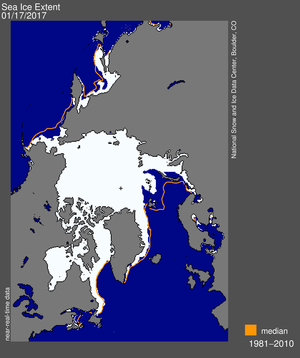Two new papers from the Circumpolar Flaw Lead (CFL) Systems Study will be published soon in a special issue of Polar Biology. They can be accessed below.
Collins RE, Deming JW (2011) Abundant dissolved genetic material in Arctic sea ice Part I: Extracellular DNA. Polar Biology.
[doi: view online] [Article PDF] [Supplementary Materials PDF] [References .bib]
Abstract
The porous medium of sea ice, a surface-rich environment characterized by low temperature and high salinity, has been proposed as a favorable site for horizontal gene transfer, but few measurements are available to assess the possibility of this mode of evolution in ice. Here, we report the first measurements of dissolved DNA in sea ice, measured by fluorescent dye staining of centrifugal-filter-concentrated samples of melted ice. Newly formed landfast and pack ice on the Canadian Arctic Shelf (ca. 71°N, 125°W) contained higher concentrations (scaled to volume of brine) of the major components of dissolved DNA—extracellular DNA and viruses—than the underlying seawater. Dissolved DNA was dominated by extracellular DNA in surface seawater (up to 95%), with viruses making up relatively larger fractions at depths below 100 m (up to 27%) and in thick sea ice (66–78 cm; up to 100%). Extracellular DNA was heterogeneously distributed, with concentrations up to 135 μg DNA L^−1 brine detected in landfast sea ice, higher than previously reported from any marine environment. Additionally, extracellular DNA was significantly highly enriched at the base of ice of medium thickness (33–37 cm), suggestive of in situ production. Relative to underlying seawater, higher concentrations of extracellular DNA, viruses, and bacteria, and the availability of numerous surfaces for attachment within the ice matrix suggest that sea ice may be a hotspot for HGT in the marine environment.
Collins RE, Deming JW (2011) Abundant dissolved genetic material in Arctic sea ice Part II: Viral dynamics during autumn freeze-up. Polar Biology.
[doi: view online] [Article PDF] [Supplementary Materials PDF] [References .bib]
Abstract
Viruses play a significant role in nutrient cycling within the world’s oceans and are important agents of horizontal gene transfer, but little is know about their entrainment into sea ice or their temporal dynamics once entrained. Nilas, grease ice, pancake ice, first-year sea ice floes up to 78 cm in thickness, and under-ice seawater were sampled widely across Amundsen Gulf (ca. 71°N 125°W) for concentrations of viruses and bacteria. Here, we report exceptionally high virus-to-bacteria ratios in seawater (45–340) and sea ice (93–2,820) during the autumn freeze-up. Virus concentrations ranged from 4.8 to 27 × 10^6 ml^−1 in seawater and, scaled to brine volume, 5.5 to 170 × 10^7 ml^−1 in sea ice. Large enrichment indices indicated processes of active entrainment from source seawater, or viral production within the ice, which was observed in 2 of 3 bottle incubations of sea ice brine at a temperature (−7C) and salinity approximating that in situ. Median predicted virus-to-bacteria contact rates (relative to underlying seawater) were greatest in the top of thick sea ice (66–78 cm: 130×) and lowest in the bottom of medium-thickness ice (33–37 cm: 23×). The great abundance of viruses and more frequent interactions between bacteria and viruses predicted in sea ice relative to underlying seawater suggest that sea ice may be a hot spot for virally mediated horizontal gene transfer in the polar marine environment.
Tags: bacteria · extremophiles · publications · science · sea iceNo Comments



0 responses so far ↓
There are no comments yet...add one by filling out the form below.